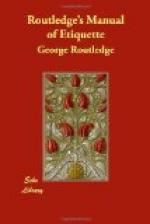For the young, cheap and inexpensive materials are often the most effective. Heavy silks and satins are out of place. It is more a question of colour and make than material. How often a bright green and white muslin, or even cotton, well made and well put on, worn by a pretty girl with a good complexion and graceful “tournure,” puts to shame and thoroughly eclipses a more costly and elaborate “toilette!” How often we have been charmed by the appearance, at the breakfast table, of a young fresh looking girl, who in her simple and unpretending, but well-selected attire, suggests all that is most beautiful in nature, the early sunrise, the opening rose-bud, encased in its calix of tender green! Such a sight has refreshed while it has gratified the eye, and if the young only knew how very little is required to add to those charms which are the property of youth, they would not be at so much pains to copy those elaborate “toilettes” which seem to be invented only to repair the inroads and damages of years, and to enrich the dressmakers, and which are quite “de trop,” quite out of place with the young. Many are the materials which suit the young and which are inexpensive. Alpacas of various shades, muslins, foulards, tarlatan, tulle, light silks, light in texture as well as colours. These are not expensive materials. We remember at this moment an exceedingly effective costume, made of white alpaca with a narrow green stripe, which was worn with a crinoline bonnet trimmed with mauve. The bonnet and dress did not cost more than L2 10s., and scarcely as much. It was made at home, and all that was required for the gown was nothing when compared to the bills which the most ordinary dressmaker would have run up for tapes and buttons, and hooks and eyes.
But dressmakers have their fortunes to make, and it is well for them that there are people in the world who are rich enough to employ them. Some dressmakers refuse to make up what is called “the lady’s own materials,”—that is, they require their customers to buy the materials of them, and therefore it is by no means difficult to understand that, under such circumstances, a dressmaker’s bill may reach any amount, and their profits become enormous.
Compared with the supplies of thirty years ago there is no doubt that the materials out of which ladies may make their selection have increased very considerable. The variety of foulards, of gauzes, of alpacas, of camlets, of poplins, poplinettes, and Japanese silks, and even of silks themselves, which vary from three shillings to eight and nine shillings the yard, of satins, of velvets, and velveteens, have brought dress within the scope of moderate incomes. Each year some novelty is introduced, and a clever hit in the name given to it makes it popular; just as that of “Japanese silk” made people run eagerly after a material of home manufacture, which is made of silk and cotton. There are a host of other materials cheaper still, which may be obtained for




